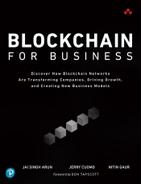7
Understanding Financial Models, Investment Rubrics, and Model Risk Frameworks
In blockchain, decentralization manifests in the corporate structure, technology governance, GRC policy frameworks, and all the constructs of the financial model, from investment rubric to ROI modeling.
—Nitin Gaur
Although technology design and business models dominate planning and conversation related to blockchain projects, understanding the blockchain monetization strategy is an important and fruitful exercise for any business contemplating a blockchain project. The monetization strategy is a difficult problem to solve for both permissioned and permissionless blockchain networks due to the lack of maturity (and thus standardization) of technology design and emerging business models that aim to use the technology landscape. Blockchain technology has introduced new design configurations, data authentication, security, and data distribution and trust mechanisms that might evolve as a narrative during the Internet’s next era. This narrative invites comparison to the original Internet era, in which new businesses and the resulting economies were created; the upcoming era, however, will focus on value creation and transfer instead of just information exchange.
Although the notion of a flattened shared business process, distributed record keeping, and smart contracts replacing business rules might seem an unrealistic model for an established enterprise, it can create a tremendous opportunity. In particular, it enables the enterprise to divide transactions to the nth decimal point, which makes microtransactions feasible. This feasibility supports the ecosystem is rethinking monetization, through possibilities ranging from peer-to-peer to machine-to-machine transactions.
While blockchain itself provides the technology constructs to facilitate exchange, ownership, and trust in the network, it is in the digitization of value elements that asset tokenization becomes truly essential. Tokenization is the process of converting the assets and rights or claims to an asset into a digital representation, or token, within a blockchain network. This distinction between cryptocurrency and tokenized assets is important to understanding the exchange vehicles, valuation models, and fungibility across the various value networks that are emerging in the blockchain world. In particular, tokenization poses interoperability challenges regarding the technical and business issues surrounding equitable swaps.
Tokenization of assets can lead to the creation of a business model that fuels fractional ownership or the ability to own an instance of a large asset. The promised asset tokenization on blockchain-based business networks includes digitization, solving the inefficiencies of time and trust, and creating new business models and facilitating co-creation through the synergies of the network participants.
The monetizing dilemma is one of perspective. The disruptors are focused on microtransactions (a claim on an instance as opposed to the whole asset), initial coin offerings (ICOs), and security token offerings (STOs), which address fundraising needs. In contrast, the enterprise is focused on efficiency, cost savings, shared costs of business processes, and other factors. This diversity adds an interesting tangent to the quest to create an ecosystem that can be both robust and symbiotic.
The following monetization strategies are often employed by the ecosystem:
Token-based models: Operation fees are used to write to the blockchain-powered business network’s distributed database.
Tokens as a medium of exchange: Tokens are traded, lent, or sold as a step-through currency.
Asset-pair trading: Margins are monetized.
Commercialization of the protocol: Technology services are monetized, including cloud and software, lab, and consulting services.
An individual monetization strategy must be selected to drive the investment rubric of blockchain projects and all related financial modeling, including financial considerations, the return on investment (ROI) model, the risk model, the risk framework, and the overall investment rubric. The chosen strategy, in turn, serves as a guide to define the progress, risk, and expected outcome of the project.
Understanding Blockchain Project Financial Fundamentals
Blockchain-based networks offer the opportunity to develop new business and trust models, which is why the phrase “revolutionary potential” is appropriate when referring to blockchain. These networks’ ability to support multiparty collaboration related to shared, trusted data and process automation across organizational boundaries brings benefits to many levels, starting with efficiency gains and culminating in reinvention of how entire industry ecosystems operate.
Blockchain initiatives fall into two main categories:
Improvements of existing process flows. Good use case candidates include the following:
Any scenario that involves multiple parties that are wasting time and resources reconciling data when they should be viewing the same data
Situations where fraud may arise due to a lack of timely information
Processes where efficiency gains and other benefits can be achieved if all participants have visibility across an entire supply or value chain
New business and service models. Most of these models have not been invented yet, but we can see emerging enterprise blockchain networks that open new markets (such as affordable trade finance for smaller businesses) or rethink how individuals, public authorities, and business interact without compromising data privacy and commercial confidentiality, and minimizing fraud risk.1
Figure 7.1 describes how as size of blockchain network grows, the business impact grows correspondingly in the industry and economy.
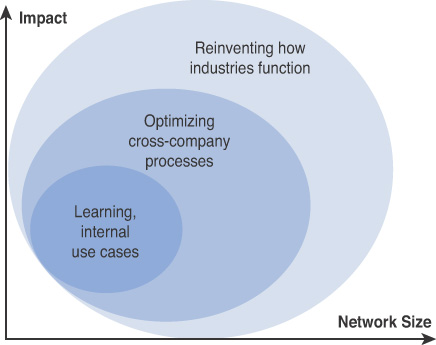
The idea of applying a structured and systematic approach to assessing blockchain financial fundamentals might seem like an obvious task. Due to the complex technology landscape, the decentralized nature of network operations, and the resulting business model, however, additional considerations may arise regarding the use of proven techniques and tools that force us to rethink the financial fundamentals.
One approach to deal with the nascent blockchain technology and the evolving blockchain landscape is to assess the key characteristics of the key projects and identify the weakest link in the transaction network. We can employ proven qualitative and quantitative tools and measures to identify and discern the key risks. These risks can then be interpreted, and their impact and severity determined and prioritized, which will lead to a well-organized analysis of project financial factors.
Building a financial model usually starts with the process of building a business design around a new business stream or transforming an existing business stream with the goal of reducing costs through more efficient operations. After the business design is defined, the task of designing a financial model then includes indicators such as the following:
The ROI model of the project: The valuation models that are inputs into the investment decision-making process.
Partnership funding models: The sources of funds that are based on participants, founding partners, and consortium models.
Business structure: An equitable economic model of the network that incentivizes investment and participation, and equally benefits the ecosystem players.
The rate of return to the founding partners, consortium, and network operators: The model that provides an equitable structure on ROI.
Financing: Debt, equity, and other models that might be necessary for the initial investment and operations while imposing a financial risk to the network infrastructure.
Governance, risk, and compliance (GRC) and model risk framework: Focus on financial liability and risk due to regulatory, compliance, and other risk elements.
Blockchain financial models are unlike many project financial models because blockchain-powered business networks contain an ecosystem, marketplaces, and a network of business-centric participants that often belong to the same industry and both compete and collaborate with each other. This model creates complexity in the business structure of the network. In particular, a single entity-driven network cannot be viewed as competitive by participants. Moreover, such a model induces centralized control, which is regarded as the antithesis to the decentralized control structure that blockchain promotes as a fundamental tenet. In blockchain, decentralization manifests in the corporate structure, technology governance, GRC policy frameworks, and all the constructs of the financial model, from investment rubric to ROI modeling. To achieve the desired ends, you must establish a specific business structure (consortium, joint venture, or other) and then devise frameworks for risk, governance, and operations before working on the financial model.
This approach addresses the political and relationship structure, and the investment and risk appetite, of the founders. To be successful, however, a consortium (a group of entities that cooperate and share resources to achieve a common objective) must have a clear and equitable financial and operating model. The funding sources, partnership structure, initial cost of investment, risk, business valuation, total addressable market of the network, regulatory burden, compliance, and related costs are inputs into the financial model analysis, as depicted in Figure 7.2.
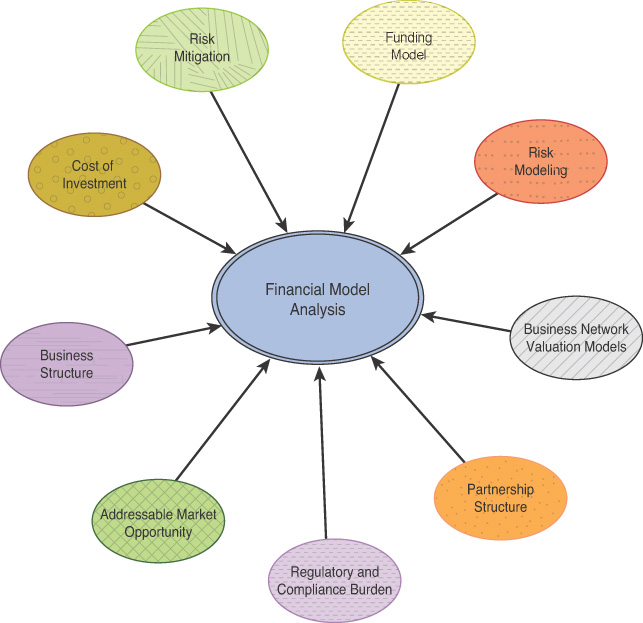
Thus, building a financial model usually starts with creating a business design around a new business stream or transforming an existing one with the goal of achieving cost reductions by adopting efficient operations. Blockchain injects complexity into this picture, owing to the decentralized control structure that blockchain promotes as a fundamental tenet. This decentralization affects the corporate structure, technology governance, GRC policy frameworks, and other constructs of the financial model, such as investment rubrics and ROI modeling. You must establish a specific business structure (consortium, joint venture, or other) and devise frameworks for risk, governance, and operations before working on the financial model.
Blockchain Investment Rubric
It is vital for an enterprise to establish an investment rubric as a risk mitigation technique. An investment rubric is a layered abstraction that represents the investment criteria and landscape. The rubric evaluation criteria have inputs, outputs, and continual analysis. The inputs are generally assumptions that drive the model, such as technology design, architecture and talent acquisition, compliance costs, and cost-efficient versus new business opportunity models. The outputs are the projected performance metrics that are measured against the stated input objectives.
The investment rubric also can serve as a model that you can use to evaluate multiple sets of performance metrics with different assumptions.
This investment rubric is both a guide and an evaluation tool for blockchain projects. The continual assets of the rubric define the merits of a potential investment and objectify the decision and justification of that investment. The rubric is a financial model that employs various business valuation techniques, such as net present value (NPV), benefit–cost ratio (BCR), internal rate of return (IRR), and GRC. Governance risk management and compliance analysis, which provide a holistic investment and risk profile, are not considered at the proof-of-concept phase.
Devising a comprehensive investment profile and model is a significant step in communicating to investors, business partners, and stakeholders the extent and depth of an analysis with a clear defensible plan for project execution, deployment, and subsequent risk mitigation that is embedded at every layer of the rubric. You can use the investment rubric as an important tool for modeling and analysis with a feedback loop mechanism. The tool is used as a scoring guide to evaluate the intended investment objective and stated outcome.
The idea behind this approach is to have a progressive development model that includes risk mitigation through continual tweaking of models to achieve the needed objectives. This model starts from proof points at the early stages of technology experimentation, and progresses to more serious efforts concerning business models and establishing a minimum viable ecosystem (MVE) while testing the risk, ROI, and financial and governance model. With new knowledge and incremental success at every stage, applying and tweaking the valuation models and risk models and establishing autonomic (sense and response) governance policies lead to growth and the scaling of the blockchain-powered business ecosystem. In summary, the investment rubric is a sophisticated tool to measure performance objectives, as depicted in Figure 7.3.
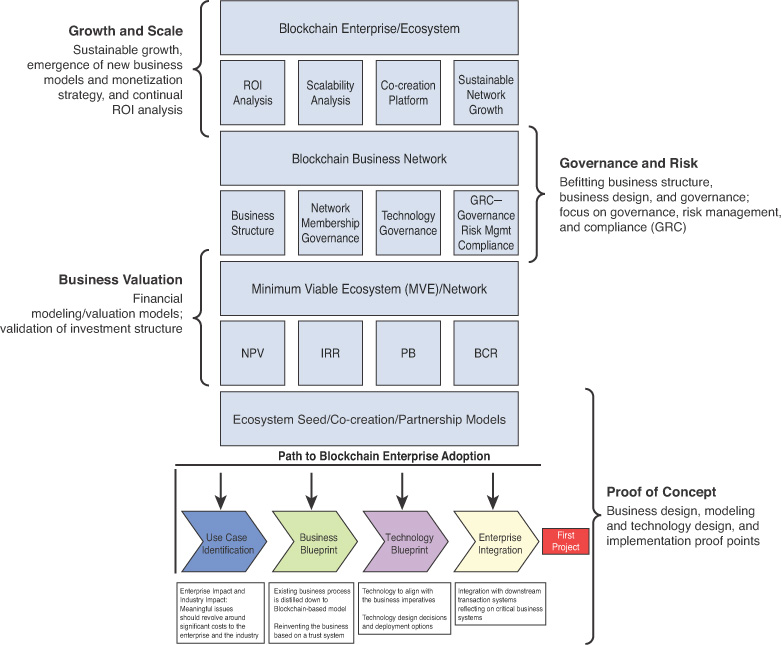
The elements of the blockchain investment rubric are discussed next.
Proof of Concept or Design
A proof of concept (PoC) or design is a tool to mitigate project risk by testing the feasibility of the blockchain network design. In blockchain enterprise adoption, we must ensure that we have a microscopic focus on a singular use case and distill the existing business into a blockchain paradigm.
As we debate the merits of signing the transactions versus mining the transactions to establish trust in the network, the blockchain-powered business network is limited only by the aspirations of the member businesses and their networks as they evolve. That is, the key factor is not a technology problem but rather a business ambition issue. A deep focus on sustainability is paradoxical because it promotes open collaborative innovation while locking down some of the constructs, such as consensus or trust systems, and governance systems that govern the assets, smart contracts, and overall interaction in a multiparty transaction network. These considerations are essential for sustainable blockchain system design.
Successful system design of the business network must align with the tenets of blockchain (trade, trust, ownership, and transactionality in a multiparty scenario). Otherwise, business networks might never realize the promise of blockchain technology in a sustainable way. To support and sustain growth, these design considerations are paramount. Initial and thoughtful investment in a PoC and design is essential to sustaining the long-term commitment regarding business models, capital commitment, and operational costs. The PoC should also be viewed as a “fail fast and fail often” model that leads to a cost-effective agile methodology.
Business Valuation
Blockchain is all about creating shared value. During the initial design phase, it is essential for founders to invite their identified MVE members to participate in discussions regarding the incentives structure, the way in which the network will operate, and the expected roles and responsibilities of each member.
Business valuation is an important task and a natural transition from technology and design proof points. The challenge of business valuation lies in identifying the appropriate valuation methodology and tools, determining funding and partnership models, devising equitable participation models (founders, normal participants, and added-value participants), and creating a business model that is focused on the neutrality of operation and network growth. This valuation consideration should be the focus of the MVE, which becomes a testbed to prove ecosystem sustainability and an input into the model promoting sustainable and continual growth of the network. The network growth can be represented by either the diversity of the ecosystem, exponential growth in transaction volumes, or creation of new business synergies due to co-creation elements of interaction between participants.
Ideally, to use MVE to drive subsequent growth in the business network, you must employ the business valuation models. Although some business models might be standardized tools, consider the possibilities for growth and emergence of new business models due to new platforms and interactions. These additional considerations are assumed with the presence of MVE as proof points.
Governance and Risk
Governance and risk are as important investment considerations, just as insurance is in personal finance. Governance models should reflect efficient, accurate, and effective risk monitoring. Effective risk modeling and governance policies are responsible investments that focus on identifying and avoiding risks that can negatively influence investment returns. The blockchain model risk framework (BMRF) defines the model and its appropriate use to derive value from blockchain investment.
Growth and Scale
Growth implies the addition of resources at the same rate as revenues increase. Scale entails adding revenues at a rapid rate while adding resources at an incremental rate. Scale leads to exponential revenue growth, while growth implies incremental or proportional increases in the business. The distinction between the two is as important as the balance between the two strategies. Sustainable growth implies the addition of new ecosystem players, which leads to the emergence of new business models and monetization options from the improved services and business model of the blockchain network, leading to scale. To achieve growth and scale, we must apply business analysis acumen and tools to continually analyze the business patterns and continually innovate to use the business network.
Clearly, it is vital for an enterprise to establish an investment rubric as a risk mitigation technique. This layered abstraction represents both the investment criteria and the broader landscape. Devising a comprehensive investment profile and model is a significant step in communicating to investors, business partners, and stakeholders the extent and depth of analysis, and developing a clear and defensible plan for project execution, deployment, and risk mitigation that is embedded at every layer of the rubric.
Return on Investment Modeling
The blockchain investment rubric provides a modeling and analysis tool to assess the investment and measure outcomes. ROI modeling can be viewed as a component of the rubric that aids in assessing the profitability of the investment. The ROI measurement is evaluated relative to the cost of the investment. The cost calculations for the capital that is committed can be complex, and the lower layers of the ROI modeling, such as business valuation and the PoC and design component, can aid in the cost of investment calculations.
ROI is a popular financial metric due to its universal applicability to all kinds of investment and capital projects. Although the various ROI models have different approaches and outcomes, ROI modeling in some form is essential to determine the preferred opportunities. ROI model analysis also exposes the risk elements that might impede achievement of the profitability objectives. In addition, it showcases the investment appetite for a project when compared to measurable cost inefficiencies or a potential new business in the blockchain network. Here is an example ROI calculation:
ROI = [(gain from investment – cost of investment) / (cost of investment)] /100
Whereas ROI aids in calculating the project’s return on investment, capital budgeting is a practice that helps determine the feasibility of investment into a long-term project. Essentially, capital budgeting provides tools that aid in analyzing cash flows and overall return for the life of the project.
Devising a meaningful ROI model for a blockchain-powered business network is a complex business and financial exercise because of the following factors:
The blockchain network is an ecosystem that is composed of many participants and ecosystem players. Their access to the ecosystem and network relies on individual investment priorities and risk appetite.
The blockchain network relies on a sound business model. It usually is not a stand-alone project, but rather is composed of many elements, such as a partnership or consortium structure, partnership funding model, and consortium-driven business model. Collectively, these elements represent a complex layer of a financial model and a structure of individual founding members.
Blockchain networks are industry-specific, and depending on the industry subsegment, the ROI models depend on the industry-driven market infrastructure and market economies.
Ecosystems address the industry-led transformation. They aspire to transform by disruption by creating efficiencies that use disintermediation. This transformation leads to emergence of new business models that do not have a defined financial, ROI, or risk model or a defined business structure. Most of the ROI analysis is based on assumptions.
A blockchain network requires availability of expertise and talent. Lack of a skilled talent pool in a blockchain technology space and lack of foundational understanding and business modeling, financial structures, and business design introduce huge project planning and operational risks for blockchain business networks, which makes ROI modeling a challenge at the beginning of the project idea.
Although the widely used valuation models provide a methodology to assess and make investment decisions, blockchain networks are about ecosystems. They represent an important progression toward disruption and a new and emerging business model. The elements for asset tokenization and the resulting token and instance economy inject an interesting twist into the valuation exercise.
Because these blockchain-based business models depict a future state and rely on network creation as a building block, some of these business models and their accompanying financial models include new assumptions and creative modeling techniques, which require vision and leadership support. The goal of an industry-specific business model must be considered in every blockchain valuation model exercise, as shown in Figure 7.4.
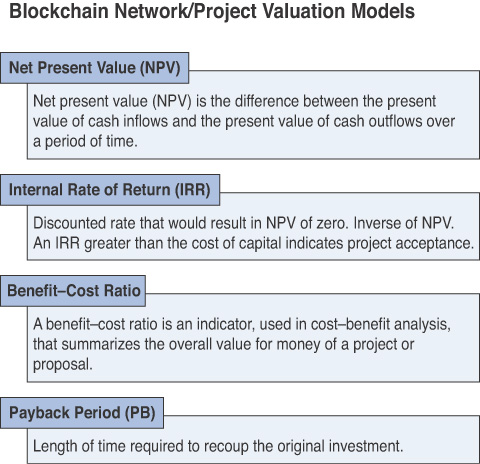
Some valuation methods used for blockchain projects are discussed next.
Net Present Value
Net present value (NPV) is a calculation that compares the amount invested today to the present value of the future cash receipts from the investment—that is, the amount that is invested is compared to the future cash amounts after they are discounted by a specified rate of return.2
NPV is a popular tool that focuses on the time value of money (TVM) concept, and ensures that the correct comparisons are made to other projects that are competing for the available investment capital. For a blockchain project, this situation is important due to the risk–reward ratios involved: Those projects that are aimed at transformation are likely to be less attractive due to other competing and more mature technology projects. However, a disruptive element and a focus on a new business stream can potentially make a blockchain project an attractive proposition.
Internal Rate of Return
The internal rate of return (IRR) is the rate at which the project breaks even. According to Knight,3 it is commonly used by financial analysts with NPV because the two methods are similar but use different variables. With NPV, you assume a discount rate for your company, and then calculate the present value of the investment. With IRR, you calculate the actual return that is provided by the project’s cash flows, and then compare this rate of return with your company’s hurdle rate (how much it mandates that investments return).3 By convention, if the IRR is higher than the hurdle rate, it is considered a worthwhile investment. IRR is a conceptual approach that can take into account the issue of growth but not scale. It depends on the subjective interpretation of the decision makers, which might make the investment justification complex and subjective.
Benefit–Cost Ratio (BCR)
The benefit–cost ratio (BCR) is a financial ratio used to determine whether the amount of money that is made through a project is greater than the costs that are incurred in executing the project. If the costs outweigh the benefits, then the project does not deliver value for money under the assumed conditions.
The BCR has two elements: (1) the benefits of a project or proposal and (2) the costs of the project or proposal. Qualitative factors, such as the benefit a project might have to society, should be expressed in monetary terms where possible to ensure an accurate result.4
BCR is an interesting valuation technique for an enterprise because it addresses the transformational elements of the project and the enterprise’s readiness for the disruptive side of the equation. When BCR is coupled with NPV to evaluate a project, you can determine the financial justification and assumptions regarding the new business models, and counter disruptive forces by ensuring that the platform and ecosystem readiness represent a long-term benefit.
Payback Period
The payback period (PB) is the length of time required to recover the cost of an investment. It is an important determinant of whether to undertake a position or project because longer payback periods are not wanted for investment positions.
The payback period ignores the TVM, unlike other methods of capital budgeting, such as NPV, IRR, and discounted cash flow.5 The payback period for blockchain projects might be an inadequate measure of ROI due to technology and inception risks. Because of the time it might take to develop an MVE and to scale the network beyond the MVE, the payback period method does not consider innovation risk and first-market advantage, which is a part of blockchain project framework.
In summary, ROI is a popular financial metric due to its universal applicability to all kinds of investment and capital projects. Devising a meaningful ROI model for a blockchain-powered business network is a complex business and financial exercise. Although these widely used valuation models provide a methodology to assess and make investment decisions, blockchain networks are about ecosystems, and present an important progression toward disruption and new emerging business models. The goal of an industry-specific business model should be a consideration in every blockchain valuation modeling exercise.
Risk Modeling
Risk modeling is about defining a model and quantifying risk, and then devising a model that can classify and profile risk. Taking calculated risk is integral to any new business, and blockchain projects are no different. It might be vital to devise a risk model and simulations to start addressing strategic, operational, compliance, and other types of industry-specific risks. The core idea is to create a robust risk profile and then devise a model to classify and institute risk mitigation strategies, thereby ensuring that the blockchain-powered business network serves the intended business model and can cope with the risk matrix that is imposed by the industry, operating environment, and technology evolution. While many blockchain business networks aim to address a specific industry (or a specific ecosystem within an industry), the network itself is subject to industry-specific risks, blockchain-driven technology risks, and the operational risks of the new ecosystem that a blockchain network aims to create.
Risk modeling seeks to understand the specific risks associated with domains (industry, technology, operations, and others) and to devise a model that can evaluate the impacts to the entire system. These impacts might be financial, reputational, or systemic. The creation of a risk model requires a simulation exercise that tests the proposed models and is used to devise a risk mitigation plan.
Perhaps you want to understand threats to your supply chain or evaluate the geopolitical risks of entering an emerging market, or how an adaptive adversary (such as a hacker or terrorist) might attack you. After risk models are developed, they can be used to evaluate not only how a system behaves under normal operating conditions but also under hypothetical “what if” scenarios. This helps organizations determine their level of risk tolerance and evaluate how to build resiliency into systems to be able to withstand various impacts.6
Figure 7.5 shows four types of risks considered in a risk model for a blockchain network or project. The presence of layers of risk elements means that to assess systemic risk, we must devise a model risk framework or a blockchain model risk framework (BMRF). A risk model is about understanding the risk matrix and constructing a robust, organic, and effective model that is based on a framework that is effective enough to adapt to changing market conditions, technology landscapes, the dynamic nature of business models, and the resulting financial structure and model of a particular industry segment.
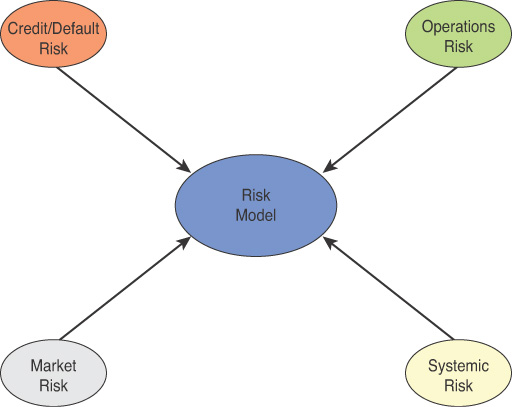
Blockchain Model Risk Framework
All blockchain business networks have a spectrum of risks, such as operational risks, regulatory risks, and financial risks. These business networks must devise a business and operational structure that will enable them to remain profitable and economically viable so as to meet the core objectives of the business entity that operates the network, and to provide the ROI required by the investors and stakeholders. Thus, BMRF acts as a vehicle to devise a mechanism to model, manage, and mitigate risk.
The BMRF discipline is relatively new but essential to providing a wide spectrum of risk analysis and instruments to contain it. At its most basic level, the BMRF defines a methodology to understand the layered risks between various blockchain network operational components and support efforts to manage, mitigate, and reduce those risks.
Although enterprises and projects might use many different risk models, a rapid shift in regulatory frameworks, the rapid evolution of the blockchain technology landscape, the lack of a qualified talent pool, and the emergence of new business models that are attributable to blockchain have prompted many of these enterprises and projects to consider using the BMRF. The idea behind devising a model risk framework is to ensure that risk management satisfies the regulatory elements and captures value effectively and thoroughly.
Within the BMRF, enterprises are prompted to use the right inputs to improve profitability through a reduced cost of compliance and optimized cost reduction, effective capital utilization, and improved operational and process efficiency. Collectively, these factors lead to efficient capture of value from the blockchain network. The value that is captured benefits the network operator as well as the network participants and ecosystem that rely on network efficiency.
The stakes in managing model risk are high. The real test of a risk model framework occurs when things go wrong:
When things go wrong, consequences can be severe. With digitization and automation, more models are being integrated into business processes, exposing institutions to greater model risk and consequent operational losses. The risk lies equally in defective models and model misuse.7
Figure 7.6 presents a comprehensive framework for financial, valuation, and risk models. The elements of the BMRF are discussed next.
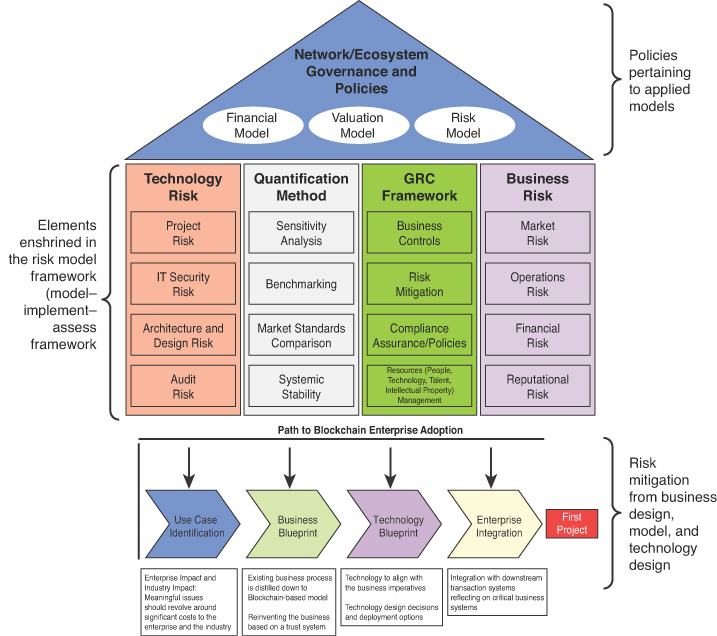
Devising a Business and Technology Blueprint
The idea behind defining the path to blockchain enterprise adoption is to ensure that we have a microscopic focus on a singular use case and that we distill the existing business into a blockchain paradigm. This idea implies the existence of both business and technology models. We take a singular use case that has an industry and enterprise impact and then apply business and technology acumen to the problem domain. The result is a well-thought-out business architecture and technology blueprint that has requirements for compliance, audit, and enterprise integration. The point of this exercise is to use the correct business domain expertise and blockchain technology expertise to derive an adoption model that enlists and surfaces hurdles, challenges, and factors to determine the economic viability of the blockchain solution.
The resulting artifacts and collateral of the blockchain engagement are instrumental in socializing and providing a blueprint for a business that seeks executive sponsorship and the necessary funding for a project. This blueprint should be the first step in use case identification and determining the risk mitigation tool to resolve business commitment challenges.
Technology Risks
Technology risks include choosing the correct technology frameworks, ensuring that our choices adhere to IT risk models, and using open standards that ensure the longevity of technology innovation as well as the availability of talent and usage of technology at a lower cost due to wider participation and adoption from the community and industry. Technology risks can lead to cost overruns in infrastructure planning, maintenance, talent acquisition, and the overall software development costs for the blockchain project. The risk elements include IT security risks, information security risks, massive cost overruns due to poor architecture and design, and talent acquisition challenges due to attrition and access to quality talent.
Quantification Risks
Quantification risks translate the probability and impact of a risk into a measurable quantity. The value or quantum of the risk, in the context of projects, is added to the project cost or time estimate as a contingency value. Project risk quantification and cost and schedule contingency are, therefore, inseparable.8
Quantification risks focus on systemic stability, benchmarking (with industry standards), and market standards comparisons. Quantification analysis can be a difficult task, especially the first time that we build a certain kind of project. In such a case, there is no available benchmarking or other project-specific data, which makes this project high risk.
GRC Framework
Governance, risk management, and compliance are three related facets that help assure an organization reliably achieves objectives, addresses uncertainty and acts with integrity.9
Lack of business controls, risk mitigation strategies, compliance control and adherence policies, and robust policies concerning intellectual property (IP), talent, and personnel lead to systemic risk due to interdependencies between the various governance frameworks. The cost of compliance (or noncompliance), erroneous risk mitigation strategies, and lack of control procedures regarding IP, talent, and enterprise resources can destabilize the financial model regardless of its operational efficiency.
Business Risks
Business risks imply uncertainty in profits or the danger of loss. Some events might pose a risk due to some unforeseen circumstances in future, which cause the business to fail.10
Business risks include market risk, operational risk, financial risk, and systemic risk, which either alone or collectively contribute to the failure of a blockchain-powered business network. Spending time on creating an appropriate business model and business design is an important consideration, along with implementation of a GRC framework and risk modeling.
Blockchain Governance and Policies
Blockchain network operators must implement and define a governance structure with policies for the various models. The policy framework may be network-wide or pertain to a specific model, such as an ROI, financial, or risk model. The policies provide guidelines for dealing with model risks and create a landscape for performing analysis. Governance policies can be the first line of defense when dealing with model risks, or they can be an impediment to network operations and growth. It is vital to consider the balance between managing risk and restricting the environment in terms of growth vectors.
Risk modeling is about defining a model and quantifying risk, and then devising a model that can classify and profile that risk. It requires understanding the various domains’ specific risks and evaluating their potential impacts—financial, reputational, or systemic—on the entire system. The presence of layered risk elements implies that to assess systemic risk we might need to devise a model risk framework or BMRF. The BMRF encourages us to use the right inputs to improve profitability through a reduced cost of compliance and optimized cost reduction, effective capital utilization, and improved operational and process efficiency, all of which lead to efficient capture of value from the blockchain network.
Chapter Summary
Although many blockchain projects and networks are emerging, challenges remain in regard to addressing the technical complexity of the blockchain protocol and navigating the sea of available frameworks that claim that they can solve industry-specific inefficiencies. A key challenge is defining standards by using a framework that aims to shape the meaningful and scalable usage of blockchain technology. Despite the technology adoption challenges involved in making blockchain work for businesses, blockchain’s ability to transform businesses by creating a global platform that enables trust among participants has the potential to surpass the transformational power of the Internet.
The goal is to create a trusted digital transaction network that facilitates the exchange of value without any agency or human monitoring, control, and intermediation. This powerful concept has immense business implications. Although enterprises, industries, and the ecosystem understand this potential, the transformative and disruptive elements of a blockchain-powered business network and the lack of proven business and financial design, frameworks, and modeling are currently hindering the industrial adoption of blockchain.
Industries, consortia, and enterprises must understand and devise a framework and a model that take into account the various valuation models, financial and business structures, risk models, and governance frameworks to ensure a methodical, quantifiable, and measurable deployment of resources while effectively managing risk. These frameworks should aim to identify value by pragmatically assessing the impact, feasibility, risk, and technology deployment with granularity, and then focus on the various levels of investment, risk, governance, and ROIs with an industry- and subsector-level focus.
The model framework should aim to capture value by molding the strategic intent through an economically viable deployment of technology to shape the business network, ecosystem, and digital marketplace while addressing regulatory and compliance barriers. With the correct mixture of strategic approach, business design, financial rubric, GRC framework, and access to technology acumen and talent, a blockchain-powered business network can transform industries and businesses while being disruptive and immensely profitable.
References
1. “Emerging Technology Projection: The Total Economic Impact of IBM Blockchain—Projected Cost Savings and Business Benefits Enabled by IBM Blockchain.” www-01.ibm.com/common/ssi/cgi-bin/ssialias?htmlfid=79017679USEN.
2. www.accountingcoach.com/blog/npv-net-present-value
3. hbr.org/2016/03/a-refresher-on-internal-rate-of-return
4. bizfluent.com/how-6200049-calculate-benefit-cost-ratio.html
5. www.investopedia.com/terms/p/paybackperiod.asp
6. www2.deloitte.com/mn/en/pages/governance-risk-and-compliance/articles/risk-modeling.html
7. www.mckinsey.com/business-functions/risk/our-insights/the-evolution-of-model-risk-management
8. www.pmi.org/learning/library/quantitative-risk-assessment-methods-9929
9. go.oceg.org/grc-capability-model-red-book
10. www.investopedia.com/terms/b/businessrisk.asp#axzz27Teb1xOk
